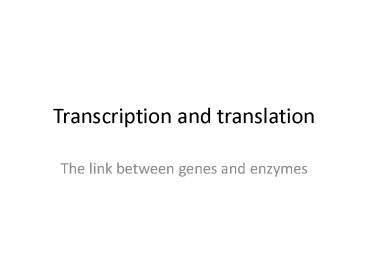Transcription and translation - PowerPoint PPT Presentation
1 / 34
Title:
Transcription and translation
Description:
Transcription and translation The link between genes and enzymes Summary Genes specify polypeptides Transcription makes RNA copies of DNA Translation involves mRNA ... – PowerPoint PPT presentation
Number of Views:392
Avg rating:3.0/5.0
Title: Transcription and translation
1
Transcription and translation
- The link between genes and enzymes
2
Inborn errors of metabolism
- A. Garrod, 1902
- Certain diseases seemed to be inherited
- Alkaptonuria due to an enzymatic defect
- Beadle and Tatum, 1941- one gene, one enzyme
- Studied Neurospora crassa
- Nutritional (auxotrophic) mutants
- Biosynthetic pathways
3
Beadle and Tatum experiment
- Pathway for arginine biosynthesis was known
- Used media with defined supplements to identify
mutants - One gene, one polypeptide hypothesis defines
relationship between DNA and protein
4
The central dogma of molecular biology
- DNA
- ?
- RNA
- ?
- Protein
5
RNA is involved in protein synthesis, too
- Messenger RNA- the gene sequence
- Ribosomal RNA- structural component of the
ribosome - Transfer RNA- interpret mRNA and build the amino
acid sequence on the ribosome - In eukaryotes
- Small nuclear RNAs-
- SRPs (signal recognition particles)
- miRNA (micro-RNA)
6
The triplet code
- Four nucleotides
- Triplets give 64 possible combinations to code
for 20 amino acids - Code is nonoverlapping
- One DNA strand serves as the template
7
Transcription RNA copied from DNA
- RNA polymerase uses DNA as a template to make RNA
- Template is the antisense strand
- 5-TACGGTACATTCGTACC ATC T -3
- 3-ATGCCATGTAAGCATGGTAGA -5
- mRNA5- UACGGUACAUUCGUACCAUCU-3
8
Deciphering the genetic code
- 64 possible codons
- Experimental requirements
- Cell-free systems with all the necessary enzymes
- Synthetic RNAs
- Nirenberg, 1961-6
- Worked with different combinations of RNAs to
deduce codons - Khorana (overlapped Nirenberg)
- Synthesized RNA molecules of defined sequences
and analyzed peptides produced - Also synthesized acetyl CoA and the first
artificial chromosome (1970)
9
(No Transcript)
10
Some exceptions to the code
- Genetic code is shared by all organisms
- Some variations in mitochondrial, chloroplast and
protozoan DNA (ribosomes are different, too) - Processes of transcription and translation are
very similar in prokaryotes and eukaryotes, but
not identical - Initiation, elongation, termination
11
Properties of RNA polymerase
- Two forms holoenzyme and core polymerase
- Need both for accurate initiation of RNA
synthesis - Promoter and start site
- Accurate termination
- Process is simpler in prokaryotes one polymerase
12
Models of transcription events
13
Operons transcription and translation coupled in
prokaryotes
repressor
Regulatory promoter
operator structural genes region
14
Eukaryotic vs prokaryotic transcription
- Eukaryotes have three RNA polymerases, each with
their own promoters - RNA polymerase I- rRNA
- Probably species-specific
- RNA polymerase II- mRNA and snRNAs
- Core promoter
- RNA polymerase III- tRNA and some small RNAs
- Promoter is internal
- All work in cell nucleus
15
Eukaryotic initiation complex contains many
cofactors
Note that transcription factors bind first
16
Elongation and termination of transcription
- Multiple molecules of polymerase can transcribe
DNA simultaneously - Termination mechanism is different in eukaryotes
17
Another difference posttranscriptional
modification
- 5 cap
- Guanine is methylated and linked to 5 end of
transcript - 3 poly-A tail
- Specific cleavage site AAUAA
- Poly-A polymerase adds poly-A tail after that
site - Splicing of pre-mRNA
18
Eukaryotic mRNA is spliced
- Introns and exons
- Much more human DNA is in introns than exons
(exons are 1-1.5 of total) - Splicing involves snRNPs
19
Model for pre-mRNA splicing
20
What are the rules for intron frequency and size?
- There are none
- Some genes have many introns, some none
- Probably accumulated over time
- Exon shuffling seen among some families of
proteins - Alternative splicing seen (remember the codon
rule)
21
Overview of translation
22
Structure of transfer RNA (tRNA)
23
tRNA charging ensures that amino acids are
positioned correctly
24
tRNA and the ribosome
- E site- for tRNA with amino acid already added
(exit) - P site- for amino acid being added (peptidyl)
- A site for the incoming amino acid (aminoacyl)
- This is where peptide bonds are formed (remember
primary structure?)
25
Initiation of translation in prokaryotesnote
the order of events
AUG is start codon first amino acid is
N-formylmethionine Methionine in eukaryotes also
more initiation factors Small subunit binds to
5-cap instead of a ribosome-binding sequence
26
Elongation cycle
Wobble pairing gives flexibility (note
orientation of anticodon)
27
Termination triggered by a stop codon
28
In eukaryotes, many proteins are processed in the
ER
- Prokaryotes have this mechanism, too
- Secreted proteins require it
29
Summary gene expression in bacteria
30
Gene expression in eukaryotes
31
Mutations occur in DNA
32
Does mutation affect phenotype?
- Triplet repeats- add to reading frame but do not
shorten it - Might be in coding or noncoding region
- Sometimes they are big enough to see in a
karyotype
33
Chromosomal mutations can have drastic effects
- Deletions
- Duplications
- Can lead to gene families and pseudogenes
- Inversions
- Translocations
- Can be fatal, can be inherited tend to arise in
single cells (somatic mutation)
34
Summary
- Genes specify polypeptides
- Transcription makes RNA copies of DNA
- Translation involves mRNA, tRNA, and rRNA in
protein synthesis - Processes are similar in prokaryotes and
eukaryotes, but there are significant differences - The genetic code is nearly universal
- Mutations alter DNA and can alter genes and
proteins - Evolution arises from mutation































